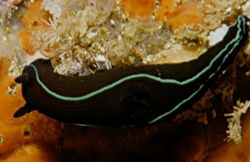Biology:Black nudibranch
| Black nudibranch | |
|---|---|

| |
| A live individual of Tambja capensis, head end towards the left | |
| Scientific classification | |
| Domain: | Eukaryota |
| Kingdom: | Animalia |
| Phylum: | Mollusca |
| Class: | Gastropoda |
| Subclass: | Heterobranchia |
| Order: | Nudibranchia |
| Suborder: | Doridina |
| Superfamily: | Polyceroidea |
| Family: | Polyceridae |
| Genus: | Tambja |
| Species: | T. capensis
|
| Binomial name | |
| Tambja capensis (Bergh, 1907)
| |
| Synonyms[1] | |
|
Nembrotha capensis Bergh, 1907 | |
The black nudibranch (Tambja capensis) is a species of colorful sea slug, a dorid nudibranch, a shell-less marine gastropod mollusk in the family Polyceridae.[1] This species is endemic to South Africa.[2]
Distribution
This species is endemic to the South African coast, being found from the Atlantic coast of the Cape Peninsula to Port Elizabeth from the shallow subtidal to at least 30 m.[3]
Description
The black nudibranch is a large (up to 80 mm) deep-bodied nudibranch. It is easily recognised because of its blue-black colour and bright turquoise marginal line. Some specimens are brownish with a purple marginal line. Its gills and rhinophores are black.[4]
Ecology
The black nudibranch feeds on tree-like bryozoans. Its egg ribbon is a bright yellow rose-like spiral.
References
- ↑ 1.0 1.1 "Tambja capensis (Bergh, 1907)". MolluscaBase. World Register of Marine Species. 2022. http://www.marinespecies.org/aphia.php?p=taxdetails&id=225522.
- ↑ "Tambja capensis (Bergh, 1907)". Species. GBIF. http://www.gbif.org/species/4359889.
- ↑ Gosliner, T.M. 1987. Nudibranchs of Southern Africa ISBN:0-930118-13-8
- ↑ Zsilavecz, G. 2007. Nudibranchs of the Cape Peninsula and False Bay. ISBN:0-620-38054-3
- Pola, Marta; Cervera, J. Lucas; Gosliner, Terrence M. (2006). "Taxonomic revision and phylogenetic analysis of the genus Tambja Burn, 1962 (Mollusca, Nudibranchia, Polyceridae)". Zoologica Scripta 35 (5): 491–530. doi:10.1111/j.1463-6409.2006.00241.x.
Wikidata ☰ Q4922401 entry
 |



